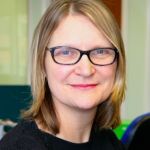 Lucy Ambrose is a GP partner and Clinical Academic as Director of the BMBS Clinical Medicine Course at the University of Nottingham.
Lucy Ambrose is a GP partner and Clinical Academic as Director of the BMBS Clinical Medicine Course at the University of Nottingham.
Do you find remote consulting tiring? At the end of the day is your head bursting and do you generally feel exhausted in a different way?
I do. First of all I blamed this on my screen, then my chair, my neck and shoulders, perhaps some health anxiety, my phone position and finally my own inherent dissonance with template consulting. This led me to consider my weariness in terms of my ways of thinking.
I had read a chapter by Stanovich° about cognitive processing. You may have read or heard about dual process theory which has been widely written about in the medical literature° led by Pat Croskerry. Dual process theory brings into play an automated form of thinking called Type 1 processes and an analytical form called Type 2 processes. As experienced doctors and GPs we complete most consultation activity in Type 1 mode. We are hardwired to default to automated processes where possible because they require less cognitive effort and we are programmed to protect ourselves. The theory hypothesises that we move to use Type 2 processes when something is not recognised or where there is a disorientating component or decoupling.
We will all have an example in our mind of a situation where we started to feel uncomfortable as an initial, seemingly clear, hypothesis becomes complex and the clarity of the diagnosis evaporates in front of us. When this happens to me, I start to go through a more detailed form of questioning and consciously consider the differential diagnosis.
We lay down memories for all the patients that we see and each memory pathway has minor detours for different presentations.
Much of the discussion about remote consulting focuses on the technology, which has moved forward with impressive speed. There is no argument about the current utility of remote consulting, my contention here is to recognise that we are thinking differently, and then to ask why and at what cost? The change in environment and the multifaceted use of photos, video and audio changes the structure of our memory pathways. We now have a different approach for familiar clinical problems. Death verification via remote video link, a multimedia approach to a single consultation and a different, fragmented diagnostic process. I am finding myself questioning every step of each activity.
We should explicitly recognise the effort in this and take it into account. The cognitive load associated with what we are doing is much higher.
Stanovich built in an additional element in his theory — that of the reflective mind. Reflection can be multifaceted and has the potential to mitigate some risks. Mezirow’s and Schon’s models of reflection and learning suggest we operate with two levels of reflective thinking. (1,2) What I call everyday reflection, and the more controlled post event critical reflection. It is the lower level that is key to mitigating risks and is our safety net here.
We have debunked presenteeism over recent times, now is the time to appraise two of our defining features, clinical reasoning and risk management for remote consulting. These are precious and vulnerable to context. We are redrawing our mental maps at scale to reset them in a remote model. We should allow for the effort involved in this endeavour, recognise the time required, and be gently reflective in an everyday manner.
References
1. Mezirow J. (2000) Learning as Transformation: Critical perspectives on a theory in progress. Jossey-Bass. San Francisco.
2. Schon DA (1987) Educating the reflective practitioner: toward a new design for teaching and learning in the professions. Jossey-Bass. San Francisco.






